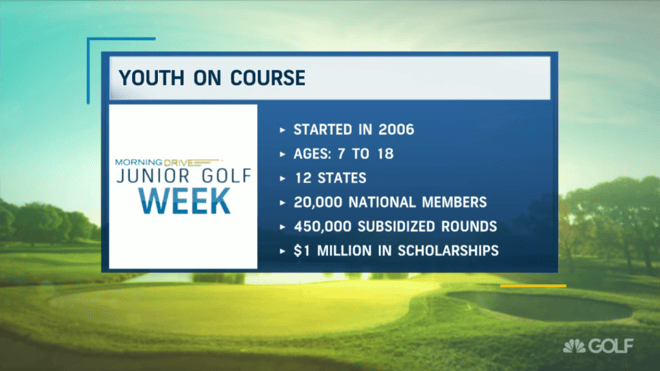This week marks the annual Junior Golf Week on the Golf Channel's Morning Drive - where industry leaders focus on grow-the-game initiatives and the programs that are developing future generations of golf.
Tuesday, October 18, 2016 - Youth on Course was featured on the Golf Channel Morning Drive when travel expert - Matt Ginella named Youth on Course his favorite junior golf program.
Watch the clip, or read the transcript below.
Special thanks to Matt Ginella of The Golf Channel for his continued support of Youth on Course.
Golf Channel's Morning Drive Transcript:
Bailey Mosier:
We are here with Matt Ginella, our travel expert, who travels the country and the globe obviously playing golf, wining and dining - but that is not all he does (plenty of that) - he is meeting junior golfers, learning about these junior golf programs from Morocco to the Nature Valley First Tee Open. So Matt, what is your favorite program, and why?
Matt Ginella:
You know inevitably going from course to course, from destination to destination, you bump into some of these junior programs and you see the kids flocking to the golf course and they are all wearing the different outfits, dressed like Ricky Fowler and Paula Creamer ... one of my favorite programs I've ever stumbled upon is Youth on Course, and that is based in Northern California - [the] Northern California Golf Association's main charitable contributions go to Youth on Course. [It] started in 2006 - the Executive Director is Adam Heieck, and he and his staff deserve a lot of credit for what is subsidized green fees. You can go out to a golf course and the junior fee is maybe $50 to play golf. I could have played three months on $50 when I was growing up as a kid. You know, [it was] $2.50 - $5 to play golf. That is what Youth on Course allows kids to play for. So they have about 300 cooperating courses that if a kid pays a very small fee and gets a membership card [for Youth on Course] - if they go to the front desk and say 'We want to play golf,' it is a maximum of $5 for that kid to play golf. The difference between that fee and what that course normally charges for a junior fee then gets reimbursed by Youth on Course - by the Northern California Golf Association. [They] send that golf course a check that makes up the difference between what is $5 green fees and what they normally charge for a junior fee.
Bailey:
So, no more than $5 is not breaking piggy banks.
Matt:
You are never paying more than $5 to play golf. It is such a popular concept - it is catching on.
Bailey:
So, talk about that - I mean it started in Northern California, but please tell me it has expanded throughout the country.
Matt:
Yeah, popular programs like this end up becoming blueprints for other state golf associations and other golf associations that want to get kids interested. If you believe that golf is a garden, then you have got to plant the seeds. Anything to get clubs in the hands of these kids is the most important thing. Teach them the rules, teach them integrity, teach them all that the game represents - and then they go on to play other sports, but they can always come back to golf. You can see here - [Youth on Course] is for ages 7-18 (stet) and is now in 12 states, they have 20 (stet) national members, 450,000 s ubsidized rounds. This is tangible. this is something that we can actually track, and it is not going to stop there - I guarantee - over the course of time, this is going to be in all 50 states.
ubsidized rounds. This is tangible. this is something that we can actually track, and it is not going to stop there - I guarantee - over the course of time, this is going to be in all 50 states.
Bailey:
Which is wonderful news, that last item we just saw on that screen, one million dollars in scholarships - what is that all about?
Matt:
So a subset of what is Youth on Course isn't just subsidized green fees- they have about 100 kids in what is their scholarship program right now. This all has to do with caddying. If a kid gets picked and ... caddies for somebody - [the kid] gets $25 cash from Youth on Course, $25 minimum from the player plus potential of tip - but also they get $50 from Youth on Course in a scholarship fund every time they caddie. So forget about how valuable that experience is as a kid carrying for what could potentially become a mentor or a life lessons learning from somebody older than them, how about the fact that they get at least $50 cash in their pocket plus $50 into a future scholarship fund that they cash in when they go to college.
Bailey:
Well, and it is probably helping to teach them about time management at a young age.
Bailey:
Everything! Work ethic! Actually working. You know I tell people all the time 'one of the greatest jobs you can have as kid is caddying' - when I consider every loop to be an internship. Life is about internships right now, gaining experience. Even if it is something you don't want to know. To learn about a profession that you might not want to do - that in itself is good value.
Bailey:
Indeed it is so where is Youth on Course going from here?
Matt:
Well, that is just it - we talked about how they have grown from 2006 into 12 states already. The goal is to get recognized nationally. Unfortunately, the PGA of America, or USGA isn't - you know - is it the cart or the horse? You know? They are not recognizing them as a national program and not getting fully behind them until they become a national program. But how do they become national without the potential help of the USGA? I feel like I would love to get these tent poles of golf to get more involved to help push a program and support a program like this - to make it go national even faster than what it is going to do organically.
Bailey:
YouthonCourse.org - a wonderful program

